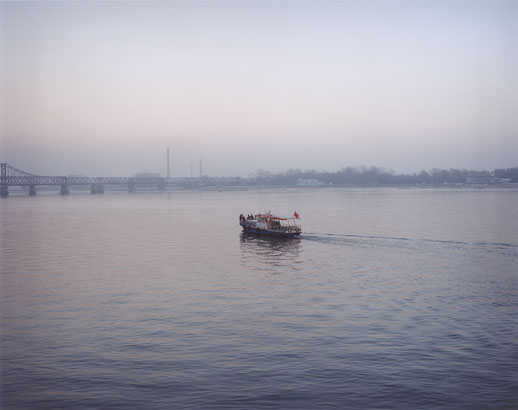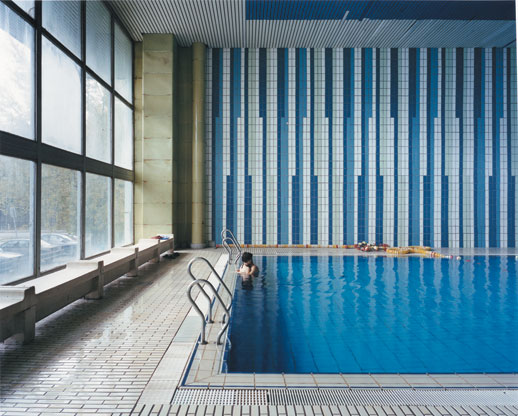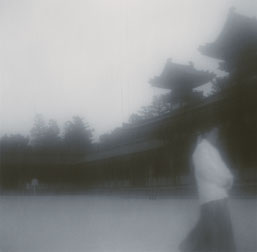Photographing the Invisible
Tomoko Yoneda’s photographs rely heavily on the camera’s ability to capture things beyond the physical scenes and objects that lie in front of the lens at that particular moment in time. Her major solo exhibition being held at Hara Museum of Contemporary Art features a selection from her representative series “Scene”, “Between Visible and Invisible”, and her latest series of work “The Parallel Lives of Others”, all of which are seemingly nondescript photographs of places (beaches, urban scenes etc) or objects (a pair of glasses, textbooks), but upon reading their titles they reveal histories or stories that are undeniably etched within the portrayed subjects.

The first floor of the museum features Yoneda’s earliest series “Topographical Analogy” as well as the newer series “Between Visible and Invisible”. “Topographical Analogy”, which in a sense reflects the essential concept that runs through her later works, consists of photographs showing walls and furniture scorched by fire. The violently burnt wallpaper conveys the heat of the fire that was present before the picture was taken — a “physical memory” of a past event. Meanwhile, “Between Visible and Invisible” shows pages of books seen through the reading glasses of key historical figures who might have read and been influenced by those particular texts: Walter Benjamin through Brecht’s glasses, Jung through Freud’s glasses, and so on. Only the words shown within the lens are in focus, and everything else outside it is blurry; the text only makes sense through the subjective “eyes” of the owner of the glasses, and in turn, the audience is only allowed to “see” the text through this subjectivity — of the glasses, or of the camera lens itself and the photographer behind it.

The filter through which Yoneda presents her photographs is not necessarily her own personal vision, but rather the collective memory of humankind, as is evident in “Scene”, and the related series “After the Thaw” and “The Parallel Lives of Others” featured on the second floor. Locations that were once battlefields (the site of Bloody Sunday in Northern Ireland, the forest where the Battle of Somme occurred in France, etc) and sites of national and political trauma are photographed as they are now, in crisp contemporary colors and often showing children or couples standing nonchalantly, apparently unaware of the implicit significance of those places. Without reading the titles, the scenes are banal; yet in becoming aware of “where” these places are, or more precisely, of the events that happened there years ago, they begin to take on a strangely unsettling quality, as if there is a silent turmoil bubbling underneath their tranquility.

The way in which Yoneda attempts to capture a certain aura or atmosphere that might exist in such key locations through the lens is similar to another Japanese photographer Shozo Agata’s series “Hanzai no Keshiki” (“Scenes of Crime”), which specifically focuses on locations of famous crimes in Japan, such as the school where the teenage murderer Seito Sakakibara left the head of his 11 year old victim at the school gates.

Yoneda’s latest series “The Parallel Lives of Others” moves more into the realm of the latter. The series consists of photographs showing numerous locations where members of the Sorge Spy Ring apparently met in secret, such as Kyoto’s Heian Shrine and Ueno Park in Tokyo. Each photo is small and hazy, where the nondescript locations are depicted in blurred black and white shapes; indeed, unlike the “official” historical locations featured in “Scene”, these are portrayals of fleeting, unofficial “non-events” that were for a long time merely fragments of a spy member’s personal memory. The exhibition’s shifting from such personal memories (“Parallel Lives…” and “Between Visible and Invisible”) and collective social memories (“Scene”, “After the Thaw”), as well as the shifting of subjectivities between the camera, the photographer, and the audience, make this a compelling and important re-questioning of the dual roles of photography as a recording tool, and as an expressive medium that projects and reflects an individual’s subjectivity.
Lena Oishi
Lena Oishi



